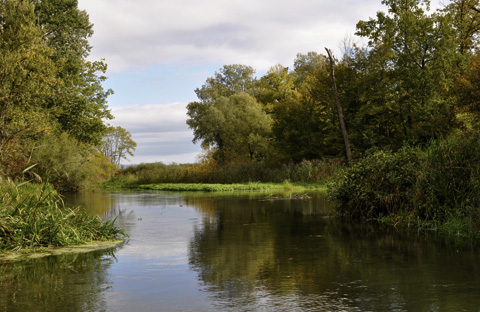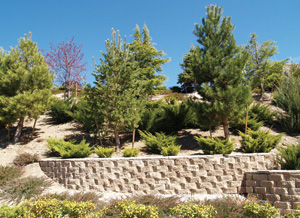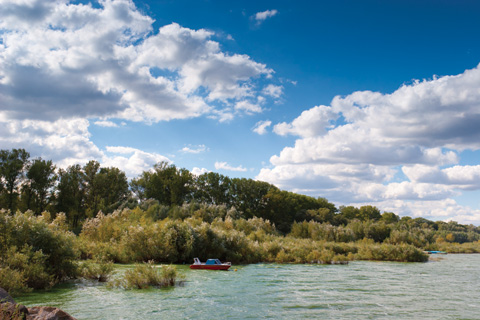If you develop your property in an eco-friendly way, you, the flora, and the fauna will all enjoy a healthy environment.
All doctors are familiar with the phrase, “First, do no harm.” It’s part of the Hippocratic Oath they swear to uphold once they become doctors. It means that they will treat patients to the best of their ability and judgment without doing them any unnecessary harm. When you are planning your new log home, why not treat it and the property you are building on as your patient and do your best not to disturb or contaminate it or the other living things you will be sharing it with?
Today, “green” is the catchword for all things home oriented. The focus is mainly on the structure and the elements that go into creating and decorating it. But, to create a sustainable site, you need to consider more than just the house. By its nature, construction destructs part of a site and significantly impacts the environment. If you select your site carefully, situate your home on it in an eco-friendly way, and develop the surrounding property to lessen the effects of soil erosion, water runoff, and pollution, you, the flora, and the fauna will all enjoy a healthy environment.
Site Selection and Home Placement
There are numerous U.S. laws restricting where you can build in the United States. The Federal Emergency Management Agency (FEMA) prohibits building below five feet above the 100-year flood elevation. You cannot build a home within 100 feet of wetlands as defined by the Code of Federal Regulations (CFR), and the U.S. Department of Agriculture prevents you from building on prime farmland. The Clean Water Act keeps your home 50 feet from any body of water, and building on habitat for endangered or critical species, both plant and animal, is against the law.
The perfect piece of land does not violate any of these laws, has a suitable location for the home, and will allow you to build with minimal environmental impact. Ideally, you will not have to perform any “invasive procedures” such as blasting bedrock or rerouting a stream. If you are building in or near the woods, some trees will have to be felled to make room for your home, but this should be controlled as much as possible. The site should be accessible to the large trucks that will bring in your logs and other building materials without destroying trees or other natural elements. If possible, limit the site disturbance to a 40-foot perimeter around the house structure. Also remember that the smaller the home’s footprint, the less impact building it will have on the environment.

When selecting a site on the property for building your home, you’ll need to consider the topography, wind orientation, solar orientation, water (both as a feature such as a pond, lake, or stream and rain and storm water), the surrounding habitat, and landscaping (how it can be used to protect your
home and its surrounding environment).
Most architects and builders would agree that the best placement for a home—and taking advantage of passive solar energy—is with its longest wall facing the south. You want to put the sun to work on heating your home in the winter but also avoid the damaging effects of solar radiation. Wind is a great asset during the hot weather, but in some locations it can have a damaging effect, especially during a winter storm. The ideal building site should offer some protection from the elements: if your area is prone to wind storms, then you may want to situate the home so it is protected by a hill or other topographical feature. The appropriate placement of the right species of trees can also help protect your home. For example, deciduous trees will provide shade in the warmer months, and when the cold
weather comes and they have shed their leaves, the sun can help warm the home.
It is essential for your architect, log home producer, and/or an engineer to review your property. If at all possible, have them visit possible land parcels before you buy them. If you intend to add solar panels to your home, install a wind turbine, or use geothermal heating/cooling, having a professional study your property is even more important.
Erosion Control
It’s important to control soil erosion, water sedimentation, and airborne dust generation during construction. Some builders use temporary and permanent seeding, mulching, earth dikes, sediment traps, and silt fencing to prevent soil from traveling into areas where you don’t want it, especially into waterways. We’ve all seen silt fencing on construction sites, but it is made of a petroleum-based product and cannot be reused or recycled. Several eco-friendly products are available that can control soil erosion either temporarily or permanently. All of these products control erosion and help vegetation to take root:
- Turf reinforcement mats
- Organic matrix
- Photodegradable/ biodegradable blankets—they degrade after the root systems and stems are mature enough to stabilize the soil
- Straw wattles—capture and keep
sediment - Once your home is built, you can plant trees and bushes, add retaining walls, or otherwise prevent soil from eroding on your property.
Stormwater and Runoff Control
Stormwater is water that originates during precipitation events, i.e., rainstorms, or from snowmelt or runoff water from overwatering or from building construction. If it doesn’t soak into the ground, it becomes surface runoff that flows into existing waterways or into storm drains, which eventually empty into bodies of water. Both the timing and volume of the water and the potential contaminants it carries affect your property and the environment in general.
Infiltration is the process by which water on the ground enters the soil. It depends on soil type and texture, water content of the soil, the temperature of the soil, and the intensity of the rainfall. The rate of infiltration slows down when the soil is saturated, and if the precipitation rate is higher than the infiltration rate, runoff will occur unless there is something to stop it. Vegetation creates a more porous soil by protecting it from heavy rain and loosening it as the roots grow.
Several innovative, eco-friendly ways to control water runoff are available.
Retention Ponds. Retention ponds capture diverted stormwater from driveways, walkways, and roofs. They hold the water before releasing it into a stream or other body of water. When the water is released it flows at a natural rate and frequency. Pollutants are removed from the water through settling and biological uptake (absorption by plants, animals, or fish). If your property has a natural slope away from your home, consider having a professional install a French drain groundwater removal system that vents into a retention pond. The system removes water from near the home and from gutter discharge. A retention pond adds value to your home because it is attractive and it provides a wildlife habitat.
Rain Garden. A rain garden is a depression that allows rainwater runoff from roofs, driveways, walkways, and compacted lawns to be absorbed. Stormwater is absorbed instead of going into a storm drain or a waterway, which will lead to erosion, pollution, flooding, and a reduction of groundwater. The garden is planted with native plants, which don’t need to be fertilized; are more tolerant to local weather conditions, soil, and water; and attract wildlife. The plants enhance water infiltration, return water vapor to the atmosphere, and reduce the amount of pollution going into creeks and streams. The water infiltrates into the ground within a day or two so is not a breeding ground for mosquitoes.

Bioswales. Bioswalesare landscape elements that are designed to remove silt and pollutants from surface water runoff. A swaled drainage trench with gently sloping sides is filled with plants, compost, and riprap (stones piled loosely in water or soft ground). Bioswales prevent silt, inorganic contaminants (phosphates and nitrates from excessive fertilization), organic chemicals (pesticides that poison wildlife and damage aquatic ecosystems), and pathogens (animal waste that can cause disease in animals and humans).
Riparian Zones. A riparian zone is the area between land and a stream or river. They are important because they play a role in soil conservation, provide habitat diversity, and influence fauna and aquatic ecosystems. They are natural biofilters that protect aquatic environments from heavy sedimentation, polluted surface runoff, and erosion. A riparian zone provides shelter for wildlife and shade that helps regulate water temperature. It can be natural or engineered. A riparian zone may be damaged during construction and may need repairing by replanting and controlling erosion.
Hardscaping
Asphalt is probably the least eco-friendly driveway surface available. It may be relatively inexpensive, but water cannot permeate it and runs off into your property. The solid black surface absorbs the heat of the sun and creates a heat island effect. A better choice would be a light-colored material with a high reflectance. As an alternative, look for porous concrete for your hardscaping.
Consider using pavers or an open lattice system that will allow water to infiltrate the soil. The same type of surface—which could be natural stone set into sand—is ideal for a patio or terrace.
To prevent soil erosion and encourage water filtration, build segmented retaining walls or use stacked landscaping blocks that follow the natural contours of the property. Site disturbance is minimal and water can move freely through a retaining wall put together without mortar. The retaining wall also serves as a filter for pollutants.

